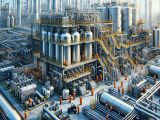
Tanaka to boost production plant hydrogen energy use with new system
April 4, 2024The company inte4nds to install a 500-kW fuel cell system as a step toward decarbonization
Tanaka Holdings Company, Ltd, has announced that it will be focusing on hydrogen energy at one of its Tanaka Precious Metals production plants by installing a pure H2 fuel cell system with a 500-kilowatt maximum generating capacity.
This makes it one of the largest uses of a fuel cell system in Japan’s private sector
The Shonan Plant using the new fuel cells for hydrogen energy is a key recycling business site located in Kanagawa Prefecture. The system being installed is the H2Rex manufactured by Toshiba Energy Systems & Solutions Corporation. The goal of using it is to come as close as possible to optimal generation efficiency. The fuel cell is expected to begin operation in 2026.
The company has already launched Operation Polaris*2, for the purpose of meeting its 2050 goal of being carbon neutral. In order to arrive at a carbon emission reduction of at least 50 percent by 2030 (when compared to the levels measured in 2013), the company has been taking calculated steps forward in areas such as manufacturing process optimization, energy efficiency enhancement, green energy solution implementation, and examining new strategies for emission reduction overall. The latest decision to move toward the use of H2 is a component of this effort.
Hydrogen energy from a pure H2 fuel cell system
The pure H2 fuel cell system Tanaka will be installing combines hydrogen with oxygen – essentially the opposite of water electrolysis. This process generates electricity without resulting in the production of carbon dioxide emissions, unlike many other sources of electricity generation that use fossil fuels such as coal or natural gas.

Moreover, beyond using hydrogen energy for powering the plant, the system can also be used for the production of a backup electricity supply that can be provided if the main grid faces an outage.
This type of system is considered to be environmentally friendly in a number of ways, not just from the lack of CO2 emissions. For instance, they also produce lower noise and vibration pollution than other forms of electricity generation, each of which is kind to local ecosystems.
Expected outcomes
The Shonan Plant will use the electricity generated by the new system when it becomes operational to supply 25 percent of its power needs. This is expected to reduce the plant’s CO2 emissions by 1,979 tons per year, according to Tanaka’s own estimates. That figure represents about 32 percent of the annual emissions emitted by the plant, only 18 percent away from its target for 2030.
Once the new system is operational, Tanaka has every intention to continue expanding the way it uses hydrogen energy. In this way, it plans to continue bringing itself closer to reaching its 2030 goal, and eventually its 2050 goal as well.
Keeping up with growing hydrogen energy demand
 Tanaka is aware that while it continues to expand its use of H2 to power its plants, the demand for the gas and hydrogen energy will also continue to grow. It is hopeful that its Kawasaki City*3 advanced H2-powered city in Kanagawa Prefecture will be successful. For this, the company aims to construct an H2 production center in the local waterfront area.
Tanaka is aware that while it continues to expand its use of H2 to power its plants, the demand for the gas and hydrogen energy will also continue to grow. It is hopeful that its Kawasaki City*3 advanced H2-powered city in Kanagawa Prefecture will be successful. For this, the company aims to construct an H2 production center in the local waterfront area.
To reach this goal, Tanaka joined the Kawasaki Carbon Neutral Port Formation Production Council as well as the Kawasaki Carbon Neutral Industrial Complex Formation Promotion Council. These two public-private consortia are comprised of companies and other organizations in collaboration for the purpose of achieving the city’s vision by way of strategies being implemented to discover and promote measures to arrive at carbon neutrality. Tanaka’s goal in joining those councils is to strengthen collaboration with the other participants.
Ready to test your knowledge on the most abundant element in the universe? Take our fun and engaging Hydrogen Quiz now! [forminator_quiz id=”58712″]



 With over 15 years of reporting hydrogen news, we are your premier source for the latest updates and insights in hydrogen and renewable energy.
With over 15 years of reporting hydrogen news, we are your premier source for the latest updates and insights in hydrogen and renewable energy.